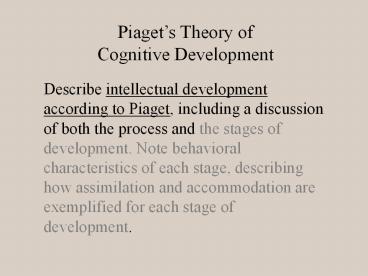Piaget's Theory - PowerPoint PPT Presentation
1 / 19
Title:
Piaget's Theory
Description:
Piaget s Theory of Cognitive Development Describe intellectual development according to Piaget, including a discussion of both the process and the stages of ... – PowerPoint PPT presentation
Number of Views:222
Avg rating:3.0/5.0
Title: Piaget's Theory
1
Piagets Theory of Cognitive Development
Describe intellectual development according to
Piaget, including a discussion of both the
process and the stages of development. Note
behavioral characteristics of each stage,
describing how assimilation and accommodation are
exemplified for each stage of development.
2
Piagets Theory of Cognitive Development
Describe specific actions that teachers can take
to incorporate Piaget's theory into the
classroom. Compare Piaget's theory to Vygotsky's
sociohistorical theory of cognitive development.
Developed by W. Huitt, 1999
3
Piagets Theory
He was a child prodigy who published his first
article in a refereed journal at the age of 11.
4
Piagets Theory
Piaget originally trained in the areas of biology
and philosophy and considered himself a genetic
epistimologist.
He was mainly interested in the biological
influences on how we come to know.
5
Piagets Theory
Piaget believed that what distinguishes human
beings from other animals is our ability to do
abstract symbolic reasoning.
6
Piagets Theory
Piaget's views are often compared with those of
Lev Vygotsky (1896-1934), who looked more to
social interaction as the primary source of
cognition and behavior.
This is somewhat similar to the distinctions made
between Freud and Erikson in terms of the
development of personality.
7
Piagets Theory
While working in Binets test lab in Paris,
Piaget became interested in how children think.
He noticed that young children's answers were
qualitatively different than older children.
This suggested to him that the younger children
were not less knowledgeable but, instead,
answered the questions differently than their
older peers because they thought differently.
8
Piagets Theory
This implies that human development is
qualitative (changes in kind) rather than
quantitative (changes in amount).
9
Piagets Theory
There are two major aspects to his theory
- the process of coming to know and
- the stages we move through as we gradually
acquire this ability.
Piagets training as a biologist influenced both
aspects of his theory.
10
Process of Cognitive Development
As a biologist, Piaget was interested in how an
organism adapts to its environment (Piaget
described this ability as intelligence.)
Behavior is controlled through mental
organizations called schemes that the individual
uses to represent the world and designate action.
11
Process of Cognitive Development
This adaptation is driven by a biological drive
to obtain balance between schemes and the
environment (equilibration).
12
Process of Cognitive Development
Piaget hypothesized that infants are born with
schemes operating at birth that he called
"reflexes."
In other animals, these reflexes control behavior
throughout life.
However, in human beings as the infant uses these
reflexes to adapt to the environment, these
reflexes are quickly replaced with constructed
schemes.
13
Process of Cognitive Development
Piaget described two processes used by the
individual in its attempt to adapt
- assimilation and
- accomodation.
Both of these processes are used thoughout life
as the person increasingly adapts to the
environment in a more complex manner.
14
Process of Cognitive Development
The process of using or transforming the
environment so that it can be placed in
preexisting cognitive structures.
Assimilation
15
Process of Cognitive Development
Example an infant uses a sucking schema that was
developed by sucking on a small bottle when
attempting to suck on a larger bottle.
Assimilation
16
Process of Cognitive Development
The process of changing cognitive structures in
order to accept something from the environment.
Accomodation
17
Process of Cognitive Development
Example the infant modifies a sucking schema
developed by sucking on a pacifier to one that
would be successful for sucking on a bottle.
Accomodation
18
Process of Cognitive Development
As schemes become increasingly more complex
(i.e., responsible for more complex behaviors)
they are termed structures.
As one's structures become more complex, they are
organized in a hierarchical manner (i.e., from
general to specific).
19
The End































